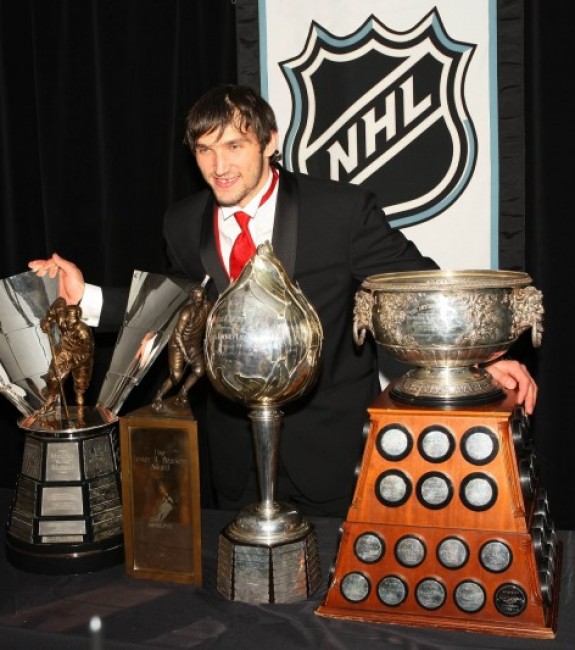The Washington Capitals are looking to make 2017 special — you know, like win the biggest present of them all, Lord Stanley’s Cup. And a team cannot get to that point without a great second half of a season. Case in point, look at archrival Pittsburgh Penguins. They were massively underachieving until coach Mike Sullivan arrived to rejuvenate the team en route to their Stanley Cup.
The Capitals have been a strong team in the Alex Ovechkin-era, including the 2007-08 squad that appeared out of the playoffs (let alone Southeast Division title race) but pulled together to make the playoffs. That desperation and mental grit is often called “playoff hockey.” Teams like to play that way as the postseason inches closer. Over the years, Washington has done it all: pulled it together in the nick of time; missed the playoffs; and coasted into the playoffs.
Beginning of Ovi-Drive
Good news: Ovechkin was drafted first overall at the 2004 NHL Entry Draft. Bad news: the Caps missed the playoffs in the spring of 2005.
Good news: Nobody made the playoffs due to the extended lockout. Bad news: One year later, Washington was a no-show for the big dance.
This time it was really unfortunate since there was actually a Stanley Cup playoff bracket. However, the Capitals were a young team with a young phenom in the making.

The last rookie to lead an NHL team throughout the season and deliver the Stanley Cup was goaltender Patrick Roy of the Montreal Canadians in 1986, and he had future Hockey Hall of Famers on his team.
The 2006-07 Washington squad did not clinch a playoff berth. Despite finishing at the bottom of league standings, they lost the draft lottery to the Chicago Blackhawks.
After opening the next season with a 6-14-1 record, Bruce Boudreau replaced Glen Hanlon behind the bench to became the 14th head coach in Capitals franchise history on Thanksgiving Day, 2007. The move turned out to be Washington’s saving grace.
The Capitals went on a tear in the second half of the season to became the first team in league history to make the playoffs after being ranked 14th or lower in conference standings at the midpoint of the season, capturing their first Southeast Division title since 2000-01. Despite playing that “playoff hockey” style, the Caps were outlasted by the Philadelphia Flyers in an exciting seven game series.
Boudreau won the Jack Adams Award for NHL’s coach of the year and Ovechkin earned the league MVP trophy among other awards with a 112 point season.

The Golden Years
The 2008-09 season started flashy for Ovechkin and ended the same way. He scored 58 points through 50 games on the path of a 110 point campaign. Washington ended the season 50-24-8 after collecting 31 wins in their first 50 games.
The Capitals carried the high flying scoring into the playoffs only to be eliminated by Pittsburgh in the second round. A classic playoff series provided the battle of hat tricks between Ovechkin and Crosby in Game Two.
In the late winter and early spring of 2010, the Capitals played like a mammoth tribe breaking every obstacle in their path. They built a 14-game win streak in January that was snapped in February in a back-and-forth 6-5 loss to the Montreal Canadiens. The team posted scoring across the board. Seven players scored
The team posted scoring across the board. Seven players scored more than 20 goals and Ovechkin and Nicklas Backstrom produced 109 and 101 points, respectively. Washington outplayed everyone so well before the 2010 Olympic Games break that they coasted into the postseason as President’s Trophy recipients.
There was anxiety in the 2010-11 locker room as the club slipped a bit from the previous year’s rocketing start. Ovechkin and company accumulated 27 wins in their first 51 games. Their play through January, February and March improved to gain 45 wins and produce a 28-7-2 record in the three month span. Washington won four of their last five games to beat out the Tampa Bay Lightning for their fourth straight Southeast Division title.
Trouble on the Horizon
If you watched the Capitals in early September 2011, you would think they were bound for Stanley Cup glory. Undefeated and fresh off whomping the Detroit Red Wings in 7-1 fashion, the team traveled to Edmonton (of all places) to capture their eighth win in eight games. It was there that Washington’s wings of momentum began to falter, as they dropped the next 11 of 16 games and closed the 2011 calendar with a 26-19-4 mark.
In terms of barely making it and flying into the playoffs, the Capitals tripped into the playoffs as the seventh seed in the Eastern Conference. The Southeast Division became more competitive as Steve Yzerman and Dave Tallon made moves to upgrade their Lightning and Florida Panthers squads, respectively.
The lockout-shortened season of 2012-13 provided a journey for Capitals fans to gloat after a sluggish start to the season. Washington turned their season around with back-to-back road wins against the Winnipeg Jets. The Capitals dominated Winnipeg by scoring 10 goals and allowing one against. Washington altered their 12-16-1 record into a 27-18-3 by season’s end, displaying their ability to rise to the occasion.
Reconstruction
It was the ‘Great Recession’ of Capitals hockey during May of 2014. Washington failed to make the playoffs for the first time since 2007, despite posting a .500% winning percentage at the start of January 2014. Two crushing losing streaks late in the season derailed hopes of a postseason. Capitals management knew front office and bench changes were coming.
Barry Trotz came in to shift the Capital machine — and their captain — toward the right direction. It took time for everyone to adjust to new leadership behind the bench. Washington posted 18 wins in their first 36 contests, but broke from the pack of wild card teams to go 37-15-4 the rest of the season. Trotz stood out as the coach of this team, unlike his predecessors. Former coaches struggled to get the most out of Ovechkin, which resulted in unfulfilled potential on the ice.
The Deepest of Them All
Trotz and company blew the door open last year. They set franchise records in wins (56), road wins (27), goaltender wins (48, tying all-time great Martin Brodeur’s single-season record) and captured their second President’s Trophy in seven years.
It seemed as though the Capitals were on autopilot throughout the season. Trotz’s system had the Capitals routing teams and going on win streaks, including five sets of win streaks lasting five games or more (Oct. 15-23, Nov. 21 – Dec. 3, Dec 12-30, Jan. 5-14, Feb. 4-11). Washington won the President’s Trophy with seven games left on the schedule.
Last year’s squad was the strongest and deepest team in franchise history during the Ovechkin era. Yes, they coasted into the playoffs. But they might have taken their foot off the gas pedal too early because Washington lost four of their last five games.
We don’t know what the Capitals will be like in 2017. The Metropolitan Division is the toughest, most competitive division in the NHL. Washington already has a five-game (Oct. 29 – Dec. 5) and six-game win (Dec. 5-16) streak to brag about, but are still bouncing between wild card spots one and two. As the season goes, one question will be on Caps management, players, and fans minds: How will the Capitals fly into the playoffs?